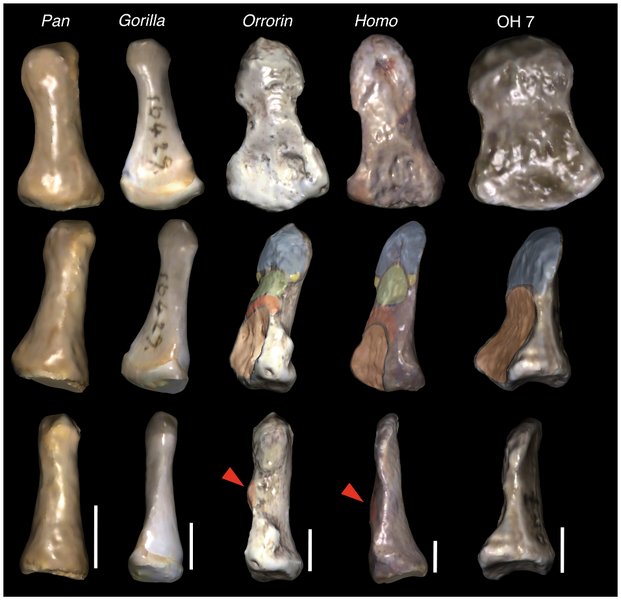Archivo: Distal-phalanges-comparison-Journal.pone.0011727.g002

Descripción: Morphological comparisons of pollical distal phalanges in African apes, extant humans and selected hominins. Specimens are showed in palmar (top), oblique proximopalmar (middle) and lateral (bottom) views, and scaled to the same length to easily visualize the morphological differences. The main features related to human-like precision grasping are indicated in the middle row, whereas the palmarly protruding insertion for the flexor pollicis longus has been further signaled in lateral view (red arrows in the lower row). Note that, although with several morphological differences, all the features related to refined manipulation in modern humans are already present in the late Miocene Orrorin. By the way, the OH 7 specimen, besides its odd overall proportions, neither shows a distinctive insertion for the flexor muscle, nor a compartmentalized digital pulp. All the phalanges belong to a right thumb. Scale bars represent 5 mm.
Título: Distal-phalanges-comparison-Journal.pone.0011727.g002
Créditos: Almécija S, Moyà-Solà S, Alba DM (2010) Early Origin for Human-Like Precision Grasping: A Comparative Study of Pollical Distal Phalanges in Fossil Hominins. PLoS ONE 5(7): e11727. doi:10.1371/journal.pone.0011727
Autor(a): Almécija, Moyà-Solà & Alba
Permiso: "2010 Almécija et al. This is an open-access article distributed under the terms of the Creative Commons Attribution License, which permits unrestricted use, distribution, and reproduction in any medium, provided the original author and source are credited."
Términos de Uso: Creative Commons Attribution 3.0
Licencia: CC BY 3.0
Enlace de Licencia: https://creativecommons.org/licenses/by/3.0
¿Se exige la atribución?: Sí
Usos del archivo
La siguiente página enlaza a este archivo:

